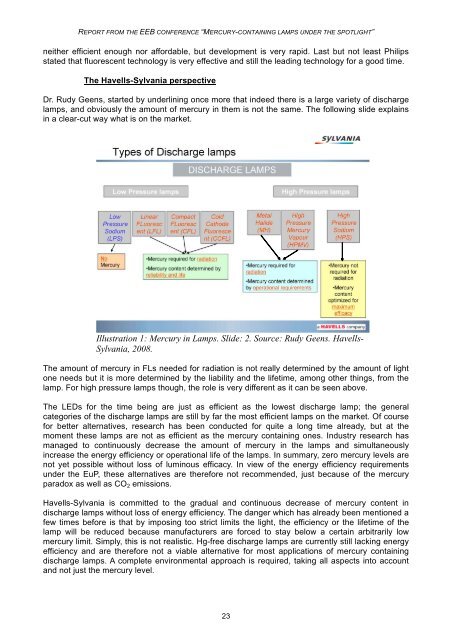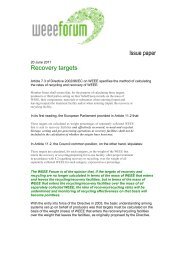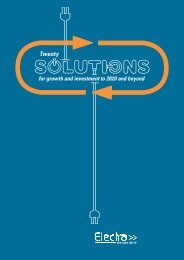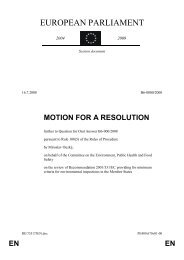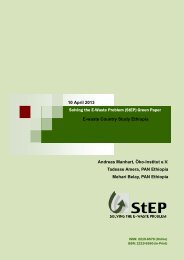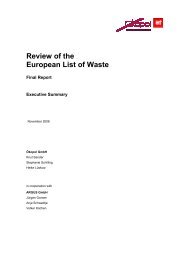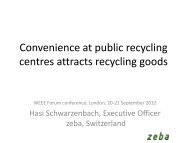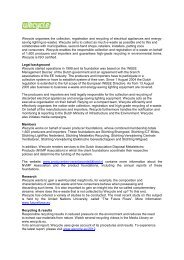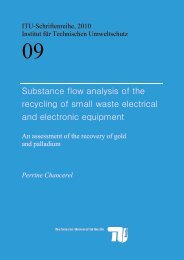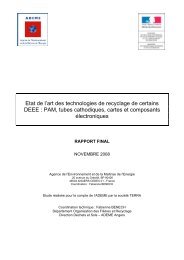Mercury containing lamps under the spotlight - WEEE Forum
Mercury containing lamps under the spotlight - WEEE Forum
Mercury containing lamps under the spotlight - WEEE Forum
Create successful ePaper yourself
Turn your PDF publications into a flip-book with our unique Google optimized e-Paper software.
REPORT FROM THE EEB CONFERENCE “MERCURY-CONTAINING LAMPS UNDER THE SPOTLIGHT”<br />
nei<strong>the</strong>r efficient enough nor affordable, but development is very rapid. Last but not least Philips<br />
stated that fluorescent technology is very effective and still <strong>the</strong> leading technology for a good time.<br />
The Havells-Sylvania perspective<br />
Dr. Rudy Geens, started by <strong>under</strong>lining once more that indeed <strong>the</strong>re is a large variety of discharge<br />
<strong>lamps</strong>, and obviously <strong>the</strong> amount of mercury in <strong>the</strong>m is not <strong>the</strong> same. The following slide explains<br />
in a clear-cut way what is on <strong>the</strong> market.<br />
Illustration 1: <strong>Mercury</strong> in Lamps. Slide: 2. Source: Rudy Geens. Havells-<br />
Sylvania, 2008.<br />
The amount of mercury in FLs needed for radiation is not really determined by <strong>the</strong> amount of light<br />
one needs but it is more determined by <strong>the</strong> liability and <strong>the</strong> lifetime, among o<strong>the</strong>r things, from <strong>the</strong><br />
lamp. For high pressure <strong>lamps</strong> though, <strong>the</strong> role is very different as it can be seen above.<br />
The LEDs for <strong>the</strong> time being are just as efficient as <strong>the</strong> lowest discharge lamp; <strong>the</strong> general<br />
categories of <strong>the</strong> discharge <strong>lamps</strong> are still by far <strong>the</strong> most efficient <strong>lamps</strong> on <strong>the</strong> market. Of course<br />
for better alternatives, research has been conducted for quite a long time already, but at <strong>the</strong><br />
moment <strong>the</strong>se <strong>lamps</strong> are not as efficient as <strong>the</strong> mercury <strong>containing</strong> ones. Industry research has<br />
managed to continuously decrease <strong>the</strong> amount of mercury in <strong>the</strong> <strong>lamps</strong> and simultaneously<br />
increase <strong>the</strong> energy efficiency or operational life of <strong>the</strong> <strong>lamps</strong>. In summary, zero mercury levels are<br />
not yet possible without loss of luminous efficacy. In view of <strong>the</strong> energy efficiency requirements<br />
<strong>under</strong> <strong>the</strong> EuP, <strong>the</strong>se alternatives are <strong>the</strong>refore not recommended, just because of <strong>the</strong> mercury<br />
paradox as well as CO 2 emissions.<br />
Havells-Sylvania is committed to <strong>the</strong> gradual and continuous decrease of mercury content in<br />
discharge <strong>lamps</strong> without loss of energy efficiency. The danger which has already been mentioned a<br />
few times before is that by imposing too strict limits <strong>the</strong> light, <strong>the</strong> efficiency or <strong>the</strong> lifetime of <strong>the</strong><br />
lamp will be reduced because manufacturers are forced to stay below a certain arbitrarily low<br />
mercury limit. Simply, this is not realistic. Hg-free discharge <strong>lamps</strong> are currently still lacking energy<br />
efficiency and are <strong>the</strong>refore not a viable alternative for most applications of mercury <strong>containing</strong><br />
discharge <strong>lamps</strong>. A complete environmental approach is required, taking all aspects into account<br />
and not just <strong>the</strong> mercury level.<br />
23


